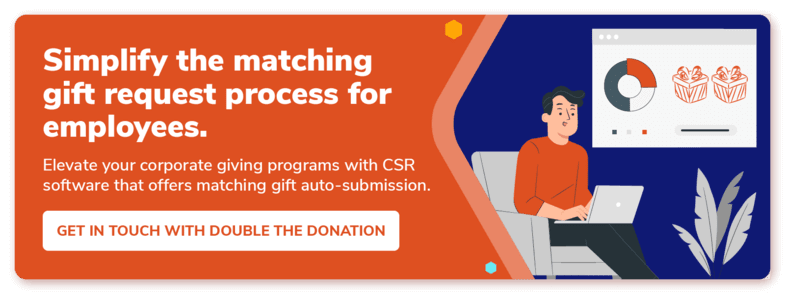Choosing the Best CSR Software: A Guide for Smart Businesses
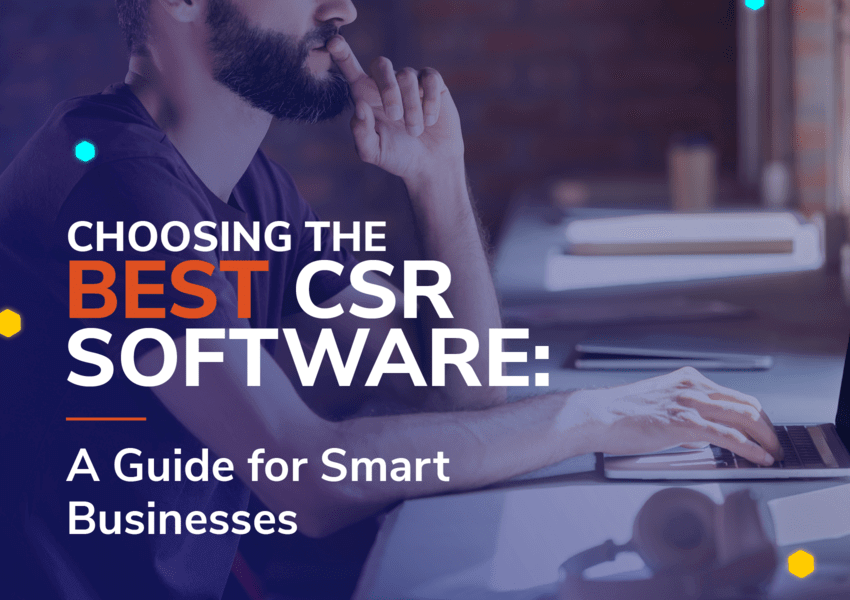
Have you ever wondered how to turn your corporate social responsibility (CSR) programs from well-intentioned efforts into strategic drivers of social impact? The answer lies in innovative CSR software.
Robust CSR software helps alleviate the struggles of managing your company’s philanthropic initiatives and measuring impact, so you can focus on driving employee participation and making bigger waves with your efforts. With diverse data sources, complex corporate giving programs, and stakeholder expectations on the rise, it’s no wonder that CSR directors are seeking advanced solutions.
If you’ve been tasked with finding the best CSR software for your company, you’ve come to the right place. This ultimate buyer’s guide will cover the essentials of selecting a platform that elevates your initiatives, including:
- The Fundamentals of CSR Software
- The Benefits of Leveraging A CSR Platform
- The Challenges of Using CSR Software
- What Are Common CSR Software Features?
- How to Select A CSR Platform
Whether you’re looking to upgrade your current software or this is your introduction to the topic, you’ll be prepared to make a smart decision. As you enter the buying process, you’ll know which features and integrations to prioritize, helping you select a platform that drives participation and grows your company’s impact.
The Fundamentals of CSR Software
Before diving into the intricacies of this type of company software, let’s make sure you know the basics. That way, you’ll know exactly what you’re looking for before booking demos with vendors.
What is Corporate Social Responsibility Software?
CSR software is a technology solution designed to help businesses manage, measure, and report on their CSR and sustainability initiatives. These platforms serve as centralized platforms to streamline the collection, analysis, and reporting of data related to a company’s social, environmental, and ethical performance.
These solutions power workplace giving programs by helping to match contributions to nonprofits, track volunteer hours, and manage other company-wide philanthropic efforts. The goal of this technology is to help companies structure valuable CSR programs to support the causes that are important to the business and its employees.
Who Uses CSR Software?
Corporate giving touches everyone within a company. There’s never only one group to consider when thinking about who will use your CSR software.
When selecting a platform, consider these likely users:
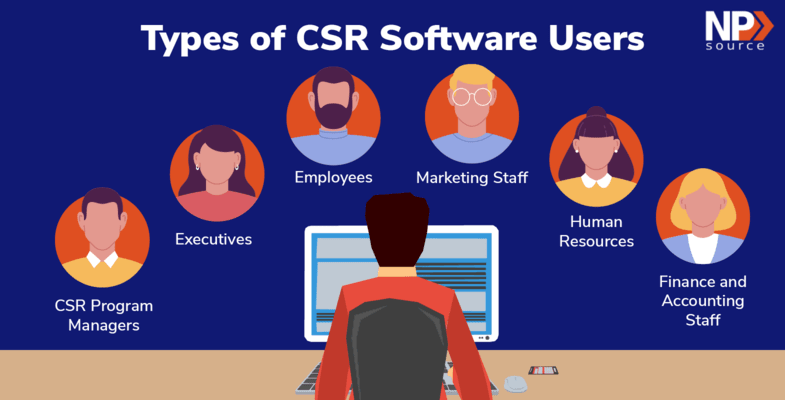
- CSR program managers: These are the most obvious users. CSR professionals are typically responsible for overseeing an organization’s CSR strategy, initiatives, and reporting, which makes access to a platform essential. They use CSR software to streamline data collection, track progress, and ensure compliance with CSR goals and standards.
- Executives: CEOs, CFOs, and other top executives may use CSR software to monitor progress toward CSR goals and assess the impact of CSR initiatives on the organization’s financial performance and reputation.
- Employees: Considering that philanthropic programs double as employee engagement tactics, employees across various departments may engage with CSR software. It will help them participate in volunteer programs, sustainability initiatives, and other CSR activities. They may also use CSR platforms to track their own contributions and impact.
- Marketing staff: Communication teams leverage CSR software to craft CSR-related messaging, create reports, and engage with external stakeholders, including the media and the public. They are critical in conveying the organization’s CSR efforts to the outside world, making them likely users.
- Human Resources (HR): HR departments might use CSR software to manage employee engagement programs, volunteer initiatives, wellness programs, and diversity and inclusion efforts. They track employee participation and measure the impact of these programs.
- Finance and accounting: Finance teams likely manage budgets and financial resources for CSR initiatives. They use CSR software to track expenses, allocate funds, and assess the financial impact of CSR efforts.
These are the most common users you’ll want to consider when selecting the best CSR software for your company, but note that other individuals, such as external stakeholders, may also use the platform.
How Much Does CSR Software Cost?
As with any type of software, pricing for CSR platforms can vary widely depending on several factors, such as the size of your company, the number of anticipated users, the complexity of your CSR programs, and the features and functionalities you require.
Here’s a quick breakdown of common expenses:
- Subscription or License Fees: Many CSR solutions operate on a subscription or licensing model. Costs can range from a few thousand dollars per year for small businesses to several hundred thousand dollars for large enterprises. Some software providers may also offer tiered pricing based on the number of users or types of CSR initiatives.
- Implementation: Onboarding your team onto the CSR software often has associated costs like data migration, training, and customization to fit your specific needs. Implementation costs might range from a few thousand dollars to tens of thousands, depending on complexity.
- Maintenance and Support: Ongoing maintenance and support fees are common with CSR software and may cover software updates, technical support, and access to new features. These expenses can vary, but they’re typically a percentage of the subscription or licensing costs.
- Customization: If you require extensive customization to align the software with your unique CSR goals, reporting requirements, or company branding, this can add to the overall cost. Additional costs depend on the complexity of your customization needs.
- Additional Features: Some CSR software providers offer add-on features to enhance your CSR programs. Common examples include volunteer management, grant management, and sustainability reporting. These may come at an additional cost.
Given the numerous variables involved, it’s best to request quotes and proposals directly from CSR software vendors. They can provide a detailed cost estimate based on your organization’s specific needs and goals.
Know that some vendors may offer free trials but may not mention it on their pricing page. Whenever you demo CSR software, ask the provider if they offer a free trial, so you can see how the platform integrates into your business’s operations.
In any case, keep your company’s priorities in mind, so you’re not paying for anything you won’t use.
The Benefits of Leveraging A CSR Platform
More companies are turning to dedicated platforms to manage their philanthropy programs, and it’s not hard to see why. Essentially, it helps them stay on top of the latest corporate philanthropy trends and make a greater impact on their communities. Some common benefits of leveraging the right CSR platform include:
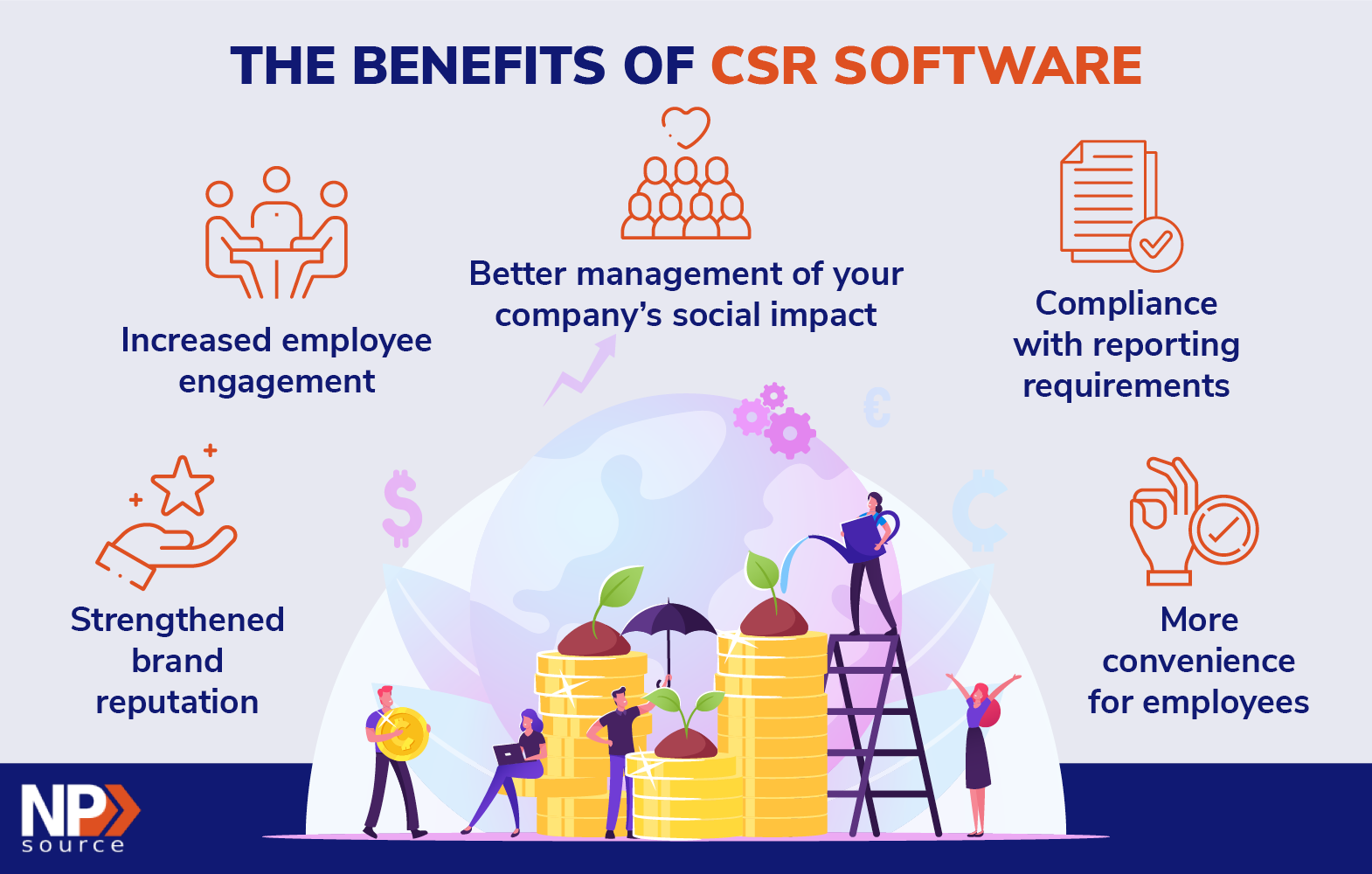
Increased Employee Engagement
One of the driving forces of CSR programs is employee engagement. These days, individuals are mindful of where they work. In fact, 54% of employees who are proud of their company’s contributions to society are engaged at work. With highly engaged employees, your company can expect 59% less turnover. CSR software makes it easy for employees to participate in your programs, while program managers can monitor participation and encourage anyone who’s underutilizing various opportunities your company provides.
More convenience for employees.
The right CSR software can transform some of the more cumbersome aspects of your CSR program into positive, seamless steps for participants. For example, let’s look at how this impacts matching gifts.
Without the help of dedicated software, donors have to take several steps to determine their d
onation’s eligibility and fill out a lengthy form just to make a matching gift. However, when you choose a CSR software provider that integrates with Double the Donation’s matching gift tool, all your employees will need to do is check a box and the software will automatically submit a request to your company.
Here’s a look at how the matching gift auto-submission process works:
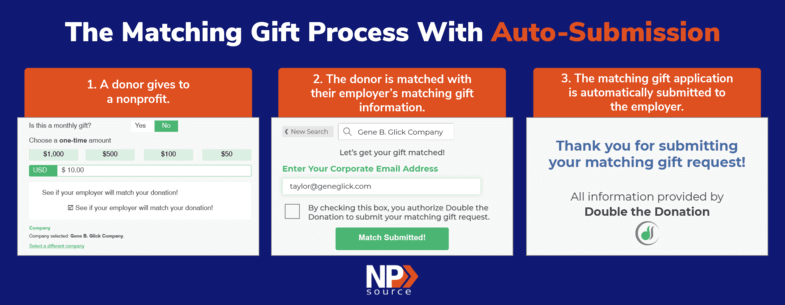
- A donor makes a gift to an approved nonprofit.
- After entering their company’s name and corporate email address, the donor is connected with the corresponding matching gift program.
- Double the Donation automatically submits a matching gift application to the employer on behalf of the employee.
Then, the request is processed, and provided the donation meets company guidelines, a matched gift is made to the nonprofit. As auto-submission features continue to grow in availability, more donors, nonprofits, and companies will benefit from it!
Strengthened brand reputation.
Being able to report on impact can help illustrate your company’s commitment to social and environmental responsibility. By making these mindful actions more transparent, you can build positive brand awareness with customers, investors, and potential employees.
Better management of your company’s social impact.
Your software will provide a centralized platform for managing, analyzing, and reporting on CSR initiatives. You’ll be able to streamline your various programs, whether you’re focused on charitable giving, employee volunteerism, sustainability efforts, or other corporate giving efforts. This comprehensive view will allow you to monitor progress toward CSR goals, identify areas for improvement, and make informed decisions.
Compliance with reporting requirements.
CSR regulations and reporting requirements vary by region and industry. CSR software can help your company comply with relevant standards, reducing the risk of non-compliance penalties and reputational damage.
The list goes on! Overall, investing in the best CSR software for your company can help you do more good in the world by cultivating meaningful, well-managed programs.
The list goes on! Overall, investing in the best CSR software for your company can help you do more good in the world by cultivating meaningful, well-managed programs.
4 Challenges to Overcome by Using CSR Software
Any tool you introduce to your company will pose challenges. What’s important is that you’re aware of these hurdles, so you can enact a plan for addressing them before they occur.
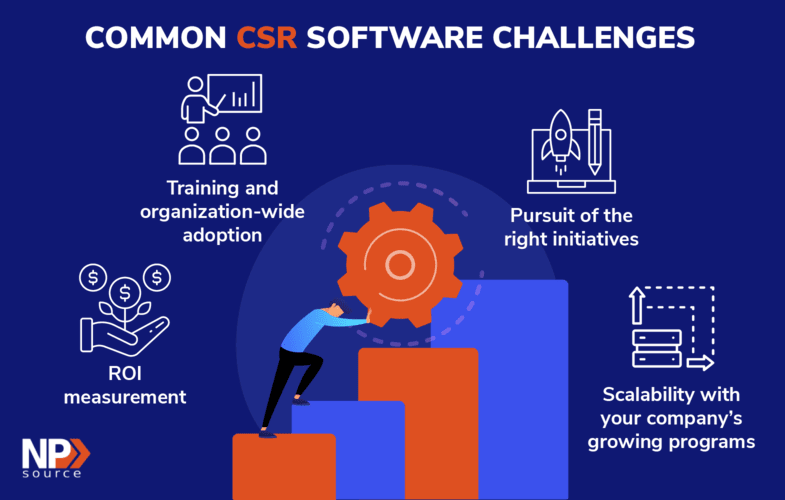
Challenge 1: Measuring ROI
Comparing the amount spent on CSR campaigns with cost savings can be a tricky undertaking. These are the areas in which companies tend to see their CSR software deliver ROI:
- Boost in Efficiency: CSR software can streamline processes related to data collection, reporting, and compliance. This can reduce the time and effort required to manage CSR initiatives. This ultimately results in cost savings and increased productivity.
- Improved Reporting: Many CSR software platforms offer robust reporting and analytics. Enhanced reporting can empower organizations to track the impact of their programs more accurately and make data-driven decisions for future initiatives.
- Enhanced Stakeholder Engagement: Effective CSR software can improve communication and engagement with stakeholders, including your employees, customers, investors, and community as a whole. This can lead to stronger relationships, increased brand loyalty, and revenue growth.
- Risk Mitigation: CSR software can help organizations identify risks related to compliance, reputation, and sustainability. By proactively addressing these risks, organizations can avoid potential financial losses.
The ROI of CSR software may not always be immediately quantifiable in monetary terms. Some benefits, such as improved reputation and employee engagement, can be challenging to measure but are still valuable to any organization with a corporate giving program.
Challenge 2: Training
While implementing CSR software often requires training your employees to use the platform effectively, it doesn’t have to be time-consuming or disrupt your team’s workflow.
Your CSR software provider should offer training to simplify the process for your team. Your organization may need training or tech support in the following areas:
- Onboarding or orientation: Initial training will help you accomplish basic tasks like setting up accounts. During onboarding, you’ll also learn about the software’s features and functionalities and how to use them.
- Customization training: Often, CSR software is customizable so you can tailor the tool to your organization’s size and unique needs. Training your team to modify the software for your organization will help you get the most out of it.
- Updates and new features: When you stick with the same provider long-term, it’s likely that they will innovate and roll out new features over the years. Ideally, they should create resources or offer training sessions that teach users to leverage these new capabilities.
- Troubleshooting and ongoing support: Even after getting set up with your software, you may have questions or run into issues you aren’t sure how to solve. In this case, you’ll need to reach out to tech support for help.
In addition to the training and support offered, consider the integration potential your provider offers. For example, CSR software providers like Millie, POINT, Selflessly, and Givinga integrate with Double the Donation’s matching gift tool, enabling donors to use the platform’s auto-submission tools. And if your solution integrates with tools your team already knows how to use, it decreases the training and lead time needed to implement the software.
Challenge 3: Pursuing The Right Initiatives
Before investing in CSR software, you need a clear vision of what programs you’re implementing. Chasing too many philanthropic opportunities will result in a lackluster CSR program that’s stretched too thin.
Know which programs you’re implementing, so you can purchase a system that supports those efforts without wasting money!
Challenge 4: Scalability
More companies are becoming aware of their social responsibility. As a result, one study found that 39% of companies have plans to expand their workplace giving programs in the next two years. Make sure your platform is equipped to handle that growth!
As your company grows, it will need a system that can support its expanding CSR initiatives. Otherwise, you might encounter challenges in scaling your software to accommodate increased complexity.
What Are Common CSR Software Features?
The CSR software landscape is extensive, making it difficult to know where to start. To help launch your research forward, we’ll share some popular features to look for in CSR platforms.
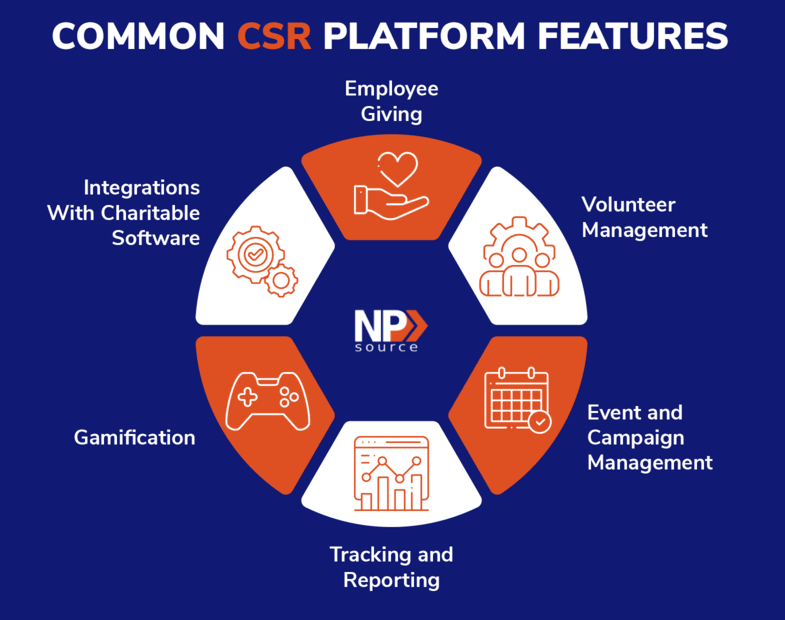
Employee Giving
This feature enables employees to make charitable donations directly through the CSR software platform. They can set up recurring donations or make one-time contributions, often with the added convenience of payroll deductions.
Many CSR software solutions also include a matching gift program feature. Launching a matching gift program enables organizations to match their employees’ charitable donations, effectively doubling the impact of individual contributions.
Corporate matching gifts are the most sought-after corporate giving programs by employees. However, 78% of donors are unaware if their company offers a matching gift program, resulting in decreased participation.
There’s an easy fix to this, though. Choose a CSR platform that integrates with a matching gift database. Then, share your company’s program guidelines with that vendor.
Overall, choosing a CSR platform that offers intuitive employee-giving features will streamline donation processes. In turn, you’ll enable employees to donate to nonprofits and access your matching gift program with ease.
 Volunteer Management
Volunteer Management
Volunteer management tools within CSR software facilitate the organization and coordination of employee volunteer activities. Depending on your software, that might include scheduling, tracking volunteer hours, or managing volunteer opportunities.
These features enable companies to organize and manage employee volunteer programs by helping employees:
- Find volunteer opportunities. Your company can identify nonprofit volunteer opportunities that align with your CSR goals and initiatives. From here, input details about each volunteer opportunity into your software. Include relevant information like the event name, date, location, and the nonprofit organization hosting the event. Employees can browse and select the opportunities they’re most interested in.
- Track volunteer hours. Either the CSR supervisor will manage a time log, or employees can self-report their volunteer hours. Regardless, your CSR software should offer the ability to track participation.
- Submit volunteer grant requests. If you offer a corporate volunteer grant program, ensure your CSR software enables you to verify nonprofits, accept volunteer grant applications, and distribute grant funds to nonprofits.
If your company values volunteerism, make sure your software will support those endeavors with relevant volunteer tools.
Tracking and Reporting
Effective tracking and reporting features are essential components of CSR software. They allow organizations to collect data related to CSR initiatives, measure progress toward goals, and generate reports for internal and external stakeholders.
Consider the following types of tracking features when selecting your CSR software:
- Volunteer hours: The software should enable employees to easily log their volunteer hours. It should also provide administrators with a dashboard to view and manage volunteer hour records. In turn, you can monitor individual employee participation and the collective hours contributed to charities.
- Donations: This feature is vital for companies that donate to nonprofits, match employee donations, or enable employees to donate part of their compensation to charity. Your software should record donation amounts, recipients, and dates. That way, you can accurately report on financial impact.
- Employee engagement metrics: Beyond volunteer hours, your software should provide insight into employee engagement in your various programs. This might include participation rates, event attendance, or employee feedback. That way, you can identify anyone who’s not participating and mitigate employee retention risks.
- Goal tracking. This feature will allow you to set targets and monitor progress toward achieving CSR objectives. In turn, these benchmarking features will help your company compare its CSR performance to industry peers and past performance.
- Finances. Robust financial reporting features will track costs associated with your initiatives, including donations, grants, and event expenses. These reports will help assess your budget allocation and overall financial impact on nonprofits.
- Compliance tracking. To adhere to relevant regulations, your software should maintain compliance records and audit trails. This ensures that all your CSR activities adhere to legal and regulatory requirements.
These are just a handful of key reporting features you should consider. By prioritizing robust reporting features, your company can effectively monitor and communicate the impact of its initiatives to internal and external stakeholders.
Event and Campaign Management
Campaign management and event management are critical functions found in CSR software. These features help organizations plan, execute, and track campaigns and events, such as fundraising drives, environmental initiatives, volunteer days, or community outreach efforts.
You should be able to coordinate logistics, invite participants, and track event- or campaign-related data.
Gamification
Incentivize participation in your program with gamification. Gamification features vary widely but follow the same premise: they introduce elements of game design to motivate employees and stakeholders to participate in CSR activities. Common examples include points, badges, and leaderboards.
Integrations
Your CSR software should integrate with other systems to enhance its functionality and simplify program management.
Take matching gift automation into account. As we explored earlier, choosing CSR software that offers this integration means you can tap into auto-submission functionality. This streamlines the matching gift submission process, increasing the likelihood of employee participation in your program.
Keep an eye out for tools like these to make your CSR initiatives more valuable. If you’re curious, reach out to Double the Donation to explore more about how prioritizing integrations like this can elevate your programs.
How to Select A CSR Platform
Now that you know the fundamentals of this type of platform, you’re ready to explore your options. Kickstart your search for the best CSR software by following these steps:
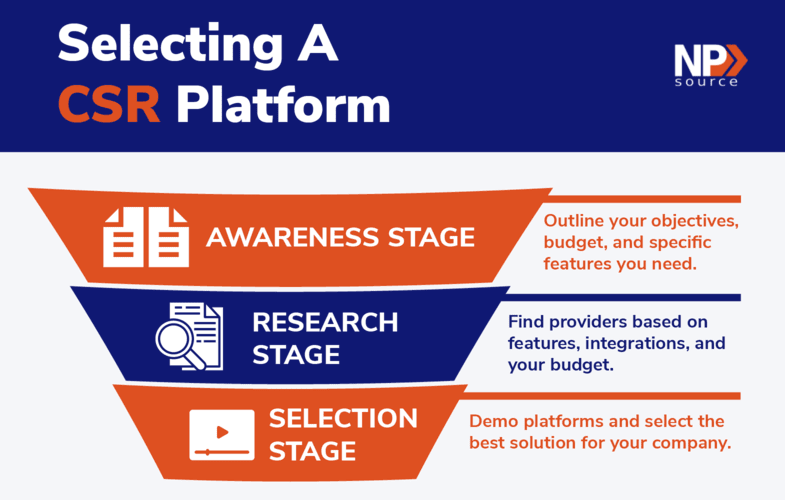
Awareness Stage
Start by defining your objectives and needs. Set your initial criteria by doing the following:
- Outline your company’s CSR objectives and identify corresponding features.
- Define your budget, so you’ll know how much you can spend on the initial software acquisition costs and ongoing maintenance and support fees.
Doing these two things first will enable you to pinpoint solutions that can support your CSR programs without blowing your budget out of the water.
Research Stage
With your priorities in mind, you’re ready to research and compare CSR platforms. Create a long list of potential providers based on must-have features and integrations.
To narrow down the list, consider your budget and each platform’s scalability based on your future plans. You can also read reviews from trusted sources or ask colleagues in your industry for their recommendations.
Selection Stage
When you’ve found a few options, demo those CSR platforms. Contact shortlisted software providers to request demonstrations and, if possible, access free trial versions of the software. You’ll want to evaluate each solution’s user experience, ability to integrate with existing systems, and scalability for future growth in your CSR initiatives.
From here, you’re ready to make your final selection. Select the CSR software that best aligns with your objectives, needs, and budget. Work with your vendor to develop an implementation plan and timeline, involving relevant departments and stakeholders.
Once you’ve selected your platform, train program managers, employees, and other users. Encourage adoption throughout your organization to make the most of your new platform and elevate your corporate giving program.
Final Thoughts: Streamlining Your CSR Programs with Software
Choosing the best CSR software for your company can supercharge your programs and help you positively impact society. Don’t necessarily pick the first solution you come across. Do plenty of research and bear in mind what we covered in this ultimate buyer’s guide. In turn, you’ll wind up with a solution that supports your goals, skyrockets employee engagement, and empowers you to do more good in the world.
Not quite ready to make a decision? Dive deeper into the world of corporate giving with these resources:
- How to Advocate for a Matching Gift Program to Your Employer. Are you intrigued by the idea of launching a matching gift program? Here’s how you can get your company on board with bringing your vision to life.
- From Cubicle to Community: How to Empower Workplace Giving. CSR software often supports workplace giving. Learn the value of these programs and get step-by-step instructions for launching your own.
- Company Spotlight: Get Inspired by Checkr’s Groundbreaking Matching Gift Program. Want to see how one company leveraged technology to power its corporate giving efforts? Explore this article on how Checkr used its CSR software to strengthen its matching gift program.

